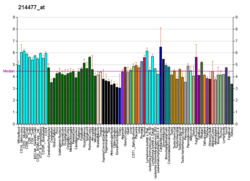Protein-coding gene in the species Homo sapiens
Protein ENL is a protein that in humans is encoded by the MLLT1 gene .[ 5]
MLLT1 has been shown to interact with CBX8 .[ 6]
^ a b c GRCh38: Ensembl release 89: ENSG00000130382 – Ensembl , May 2017^ a b c GRCm38: Ensembl release 89: ENSMUSG00000024212 – Ensembl , May 2017^ "Human PubMed Reference:" . National Center for Biotechnology Information, U.S. National Library of Medicine .^ "Mouse PubMed Reference:" . National Center for Biotechnology Information, U.S. National Library of Medicine .^ "Entrez Gene: MLLT1 myeloid/lymphoid or mixed-lineage leukemia (trithorax homolog, Drosophila); translocated to, 1" .^ García-Cuéllar MP, Zilles O, Schreiner SA, Birke M, Winkler TH, Slany RK (January 2001). "The ENL moiety of the childhood leukemia-associated MLL-ENL oncoprotein recruits human Polycomb 3" . Oncogene . 20 (4): 411– 9. doi :10.1038/sj.onc.1204108 PMID 11313972 .
Tkachuk DC, Kohler S, Cleary ML (November 1992). "Involvement of a homolog of Drosophila trithorax by 11q23 chromosomal translocations in acute leukemias". Cell . 71 (4): 691– 700. doi :10.1016/0092-8674(92)90602-9 . PMID 1423624 . S2CID 11801536 . Thirman MJ, Levitan DA, Kobayashi H, Simon MC, Rowley JD (December 1994). "Cloning of ELL, a gene that fuses to MLL in a t(11;19)(q23;p13.1) in acute myeloid leukemia" . Proceedings of the National Academy of Sciences of the United States of America . 91 (25): 12110– 4. Bibcode :1994PNAS...9112110T . doi :10.1073/pnas.91.25.12110 PMC 45386 PMID 7991593 . Rubnitz JE, Morrissey J, Savage PA, Cleary ML (September 1994). "ENL, the gene fused with HRX in t(11;19) leukemias, encodes a nuclear protein with transcriptional activation potential in lymphoid and myeloid cells" . Blood . 84 (6): 1747– 52. doi :10.1182/blood.V84.6.1747.1747 PMID 8080983 . Yamamoto K, Seto M, Komatsu H, Iida S, Akao Y, Kojima S, Kodera Y, Nakazawa S, Ariyoshi Y, Takahashi T (October 1993). "Two distinct portions of LTG19/ENL at 19p13 are involved in t(11;19) leukemia". Oncogene . 8 (10): 2617– 25. PMID 8378076 . Lavau C, Luo RT, Du C, Thirman MJ (September 2000). "Retrovirus-mediated gene transfer of MLL-ELL transforms primary myeloid progenitors and causes acute myeloid leukemias in mice" . Proceedings of the National Academy of Sciences of the United States of America . 97 (20): 10984– 9. Bibcode :2000PNAS...9710984L . doi :10.1073/pnas.190167297 PMC 27135 PMID 10995463 . García-Cuéllar MP, Zilles O, Schreiner SA, Birke M, Winkler TH, Slany RK (January 2001). "The ENL moiety of the childhood leukemia-associated MLL-ENL oncoprotein recruits human Polycomb 3" . Oncogene . 20 (4): 411– 9. doi :10.1038/sj.onc.1204108 PMID 11313972 . Nie Z, Yan Z, Chen EH, Sechi S, Ling C, Zhou S, Xue Y, Yang D, Murray D, Kanakubo E, Cleary ML, Wang W (April 2003). "Novel SWI/SNF chromatin-remodeling complexes contain a mixed-lineage leukemia chromosomal translocation partner" . Molecular and Cellular Biology . 23 (8): 2942– 52. doi :10.1128/MCB.23.8.2942-2952.2003 . PMC 152562 PMID 12665591 . Gué M, Sun JS, Boudier T (January 2006). "Simultaneous localization of MLL, AF4 and ENL genes in interphase nuclei by 3D-FISH: MLL translocation revisited" . BMC Cancer . 6 : 20. doi :10.1186/1471-2407-6-20 PMC 1388228 PMID 16433901 . Olsen JV, Blagoev B, Gnad F, Macek B, Kumar C, Mortensen P, Mann M (November 2006). "Global, in vivo, and site-specific phosphorylation dynamics in signaling networks" . Cell . 127 (3): 635– 48. doi :10.1016/j.cell.2006.09.026 PMID 17081983 . S2CID 7827573 . Meyer C, Burmeister T, Strehl S, Schneider B, Hubert D, Zach O, Haas O, Klingebiel T, Dingermann T, Marschalek R (March 2007). "Spliced MLL fusions: a novel mechanism to generate functional chimeric MLL-MLLT1 transcripts in t(11;19)(q23;p13.3) leukemia". Leukemia . 21 (3): 588– 90. doi :10.1038/sj.leu.2404542 . PMID 17252016 . S2CID 34843802 .
This article incorporates text from the United States National Library of Medicine , which is in the public domain .
(1) Basic domains
(1.1) Basic leucine zipper (bZIP )(1.2) Basic helix-loop-helix (bHLH )
Group A Group B Group CPAS Group D Group E Group F
(1.3) bHLH-ZIP (1.4) NF-1 (1.5) RF-X (1.6) Basic helix-span-helix (bHSH)
(2) Zinc finger DNA-binding domains
(2.1) Nuclear receptor (Cys4 )
subfamily 1 subfamily 2 subfamily 3 subfamily 4 subfamily 5 subfamily 6 subfamily 0
(2.2) Other Cys4 (2.3) Cys2 His2 (2.4) Cys6 (2.5) Alternating composition (2.6) WRKY
(4) β-Scaffold factors with minor groove contacts
(0) Other transcription factors





